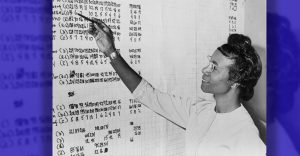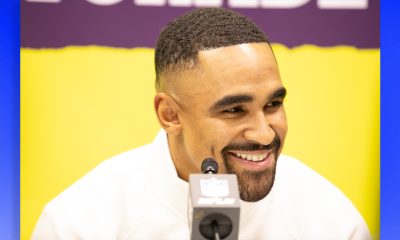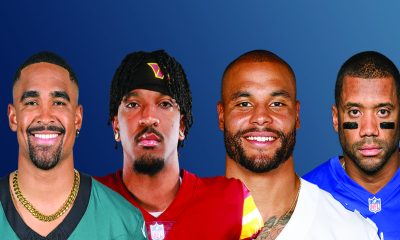Sports
Stakes High as Teams Try to Judge Character at NFL Combine

Alabama wide receiver Amari Cooper, Miami wide receiver Phillip Dorsett and Missouri wide receiver Dorial Green-Beckham wait to stretch at the NFL football scouting combine in Indianapolis, Saturday, Feb. 21, 2015. (AP Photo/David J. Phillip)
Eddie Pells, ASSOCIATED PRESS
INDIANAPOLIS (AP) — The questions were similar, and Dorial Green-Beckham had virtually the same response for each one.
“I’m disappointed in myself for all those things I did at Missouri,” said the wide receiver, who spent last season on the sideline in large part because of legal troubles, including allegations that he pushed a woman down a flight of stairs.
Green-Beckham repeated some version of that nine times during the 10 minutes he spent with reporters at the NFL scouting combine last week. He could have said it 100 times, and it wouldn’t have answered — or ended — the questions.
Because of the domestic violence scandals involving Ray Rice, Adrian Peterson and others that came to light last season, the scrutiny for the receiver with first-round talent but all those character questions is only beginning.
Now more than ever, teams are using the combine not so much to find out what sort of player they’re getting — they can watch the tapes for that — as what kind of person they’re getting. The 15-minute interviews the teams get with the players, along with tests that evaluate their psychological profile, have never been more important.
“It changes with the times,” Giants coach Tom Coughlin said of the vetting process. “We are a microcosm of society. We have our problems just like everyone else, and hopefully we will be able to help educate our people about what is not acceptable.”
Placing the issue into even sharper focus is the fact that arguably the most talented player in the upcoming draft, quarterback Jameis Winston, has been a fixture in police blotters during an athletically stellar but personally challenging three years at Florida State.
Sexual assault accusations against him while in college didn’t result in charges, but his past puts him at more risk under the NFL’s new personal-conduct policy, beefed up in the aftermath of the Rice case.
The policy, which calls for a six-game suspension after a first offense, makes clear that a criminal conviction isn’t needed for the league to determine players took part in prohibited conduct. The NFL will have its own investigative arm, and the commissioner can use his discretion based, in part, on a player’s previous behavior.
“I understand there are some things in college that a lot of people do that they wish they hadn’t later on,” said Lovie Smith, coach of the Tampa Bay Buccaneers, who hold the top pick. “I understand there are a lot of things on his record. We take all the information we can possibly get at this point. It’s still early. Right now, we haven’t taken him off our list.”
Winston’s travails have been widely documented, and with the growth of the Internet over the past decade, a few keystrokes are all it takes to discover a player’s police record. The teams work with law enforcement and hire their own people to do some detective work — talking to friends, family, high school coaches and others to uncover details about a player’s off-the-field behavior.
“I know I made mistakes and I know I have a past, but right now it’s about me moving forward and earning the trust of all these 32 teams out there,” Winston said.
Can he really move forward? The teams also hire psychologists to analyze tests that help build a psychological profile of all their prospective draft picks.
“I never felt that, as football people, we were qualified to judge whether a person was psychologically prepared to play in the National Football League,” said Bill Polian, the former NFL executive who will be inducted into the Hall of Fame this year. “We left that to the psychologist and left it to the professionals. We were guided by their opinions, which were terrific. Then, we added that to our football judgment to get a full profile.”
Among those who design the psychological tests are Dr. Mike Sanders of Human Resource Tactics. He said his tests measure mental toughness, respect for authority and work ethic, among other hard-to-quantify aspects. The HRT test given to Aaron Hernandez, the former Patriots tight end now on trial for murder, had plenty of red flags: For instance, he scored a 1 on a 1-10 scale in the category of “social maturity.”
“We point out which players may disrupt team activity,” Sanders said in a recent interview with Men’s Journal. “We use algorithms that take into account past behavior and compare scores with guys who have had problems in the past. We give teams a heads-up.”
Draft guru Mike Mayock, a former player who is now an analyst for NFL Network, thinks the decision on Green-Beckham will make for the most “polarizing conversation” of the draft. He was once considered among the top high school recruits in the nation. Based solely on his athletic ability, there’s little debate that he’d be a first-round pick. But he’s been arrested twice for marijuana possession and once for pushing a woman down the stairs. No charges were ever filed in that case, but the combination of all the problems led to the receiver’s dismissal from Missouri.
Given that record, and the current climate in the NFL, Green-Beckham is the truest definition of a high-risk, high-reward draft prospect.
“How do you not mess up? That’s your question,” Mayock said. “I’m not sure there is a right answer other than being a little more conservative. And I think we all get overwhelmed with talent and you want to buy into the fact that your building or your organization can change people when most of the time, statistically, it can’t.”
___
Online: AP NFL website: www.pro32.ap.org and AP NFL Twitter feed: www.twitter.com/AP_NFL.
Copyright 2015 The Associated Press. All rights reserved. This material may not be published, broadcast, rewritten or redistributed.
###
Alameda County
Seth Curry Makes Impressive Debut with the Golden State Warriors
Seth looked comfortable in his new uniform, seamlessly fitting into the Warriors’ offensive and defensive system. He finished the night with an impressive 14 points, becoming one of the team’s top scorers for the game. Seth’s points came in a variety of ways – floaters, spot-up three-pointers, mid-range jumpers, and a handful of aggressive drives that kept the Oklahoma City Thunder defense on its heels.

By Y’Anad Burrell
Tuesday night was anything but ordinary for fans in San Francisco as Seth Curry made his highly anticipated debut as a new member of the Golden State Warriors. Seth didn’t disappoint, delivering a performance that not only showcased his scoring ability but also demonstrated his added value to the team.
At 35, the 12-year NBA veteran on Monday signed a contract to play with the Warriors for the rest of the season.
Seth looked comfortable in his new uniform, seamlessly fitting into the Warriors’ offensive and defensive system. He finished the night with an impressive 14 points, becoming one of the team’s top scorers for the game. Seth’s points came in a variety of ways – floaters, spot-up three-pointers, mid-range jumpers, and a handful of aggressive drives that kept the Oklahoma City Thunder defense on its heels.
One of the most memorable moments of the evening came before Seth even scored his first points. As he checked into the game, the Chase Center erupted into applause, with fans rising to their feet to give the newest Warrior a standing ovation.
The crowd’s reaction was a testament not only to Seth’s reputation as a sharpshooter but also to the excitement he brings to the Warriors. It was clear that fans quickly embraced Seth as one of their own, eager to see what he could bring to the team’s championship aspirations.
Warriors’ superstar Steph Curry – Seth’s brother – did not play due to an injury. One could only imagine what it would be like if the Curry brothers were on the court together. Magic in the making.
Seth’s debut proved to be a turning point for the Warriors. Not only did he contribute on the scoreboard, but he also brought a sense of confidence and composure to the floor.
While their loss last night, OKC 124 – GSW 112, Seth’s impact was a game-changer and there’s more yet to come. Beyond statistics, it was clear that Seth’s presence elevated the team’s performance, giving the Warriors a new force as they look to make a deep playoff run.
Barbara Lee
WNBA’s Golden State Valkyries Kick Off Season with Community Programs in Oakland
“The Golden State Valkyries are more than a team—they’re a movement,” said Oakland Interim-Mayor Kevin Jenkins. “Their touchdown in Oakland marks a new era of opportunity, inspiration, and equity in sports. This partnership reflects our city’s deep commitment to uplifting women, investing in youth, and building a community where every dream has a place to grow. We’re proud to welcome the Valkyries to The Town.”
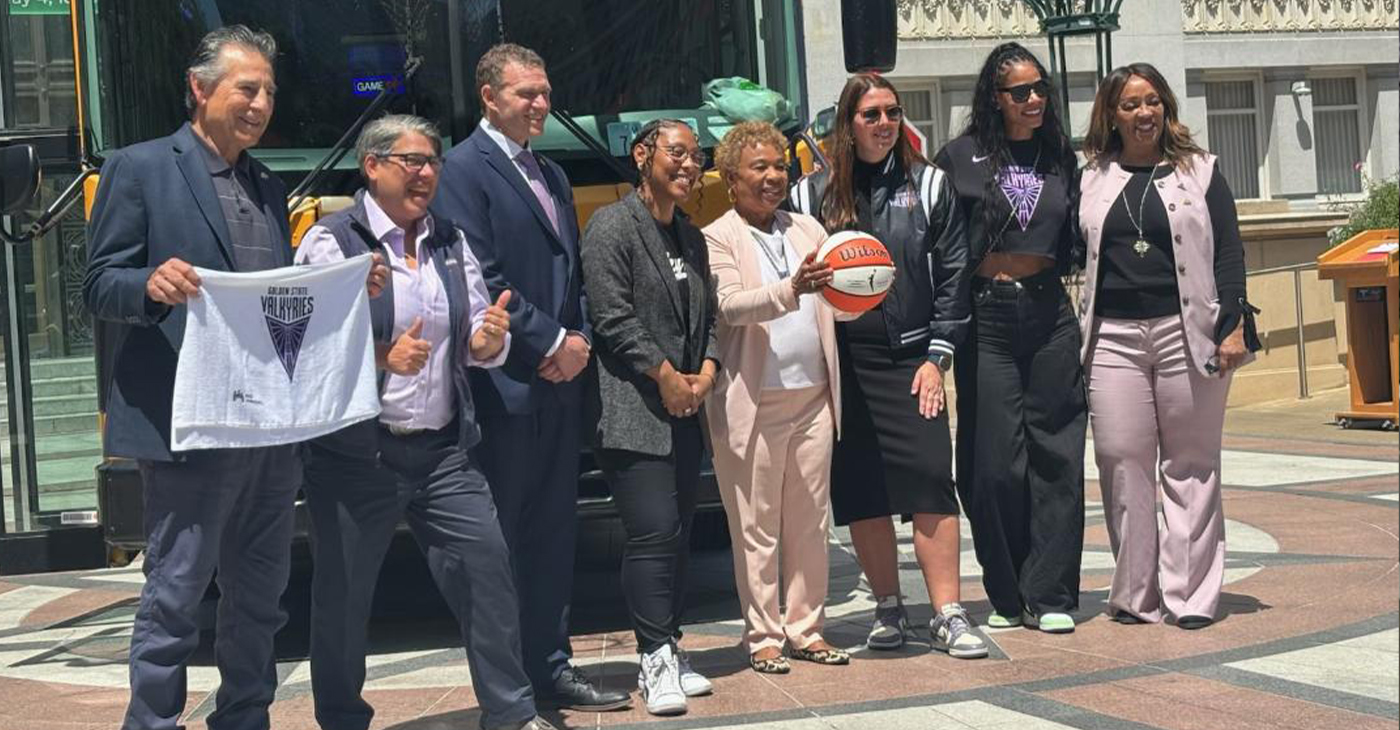
Team installs new nets at playgrounds, holds flag-raisings at City Halls in Oakland and S.F.
Special to The Post
The Golden State Valkyries brought the excitement of their inaugural season to every corner of the Bay Area with a full slate of community celebrations leading up to their historic home-opener against the Los Angeles Sparks at the Chase Center in San Francisco on Friday.
The week featured flag-raising ceremonies at city halls in Oakland and San Francisco, three “Violet Net” installation days at Oakland parks to encourage basketball play, fun “Hoopbus” takeovers at multiple schools presented by Kaiser Permanente, and player appearances.
“The Golden State Valkyries are more than a team—they’re a movement,” said Oakland Interim-Mayor Kevin Jenkins. “Their touchdown in Oakland marks a new era of opportunity, inspiration, and equity in sports. This partnership reflects our city’s deep commitment to uplifting women, investing in youth, and building a community where every dream has a place to grow. We’re proud to welcome the Valkyries to The Town.”
In total, 90 violet nets were installed on 45 basketball courts across 34 public parks throughout Oakland this week. A list of the parks receiving violet nets can be found at Valkyries.com.
About the Golden State Valkyries
The Golden State Valkyries, the WNBA affiliate of the seven-time NBA Champion Golden State Warriors, were announced as the 13th WNBA franchise on Oct. 5, 2023. According to Norse mythology, Valkyries are a host of warrior women who are fearless and unwavering – flying through air and sea alike.
This brand is Golden State’s modern interpretation of Valkyries: strong, bold, and fierce. Tipping off during the 2025 WNBA season, the team is headquartered in Oakland and will play home games at Chase Center in San Francisco. For Golden State Valkyries’ assets, including team logos, visit valkyries.com.
Activism
McClymonds High Names School Gym for Star Graduate, Basketball Legend Bill Russell
William “Bill” Felton Russell was born on Feb. 12, 1934, and died on July 31, 2022. He achieved fame as a U.S. professional basketball player who played center for the Boston Celtics of the National Basketball Association (NBA) from 1956 to 1969. He was the centerpiece of the Celtics dynasty that won 11 NBA championships during his 13-year career.
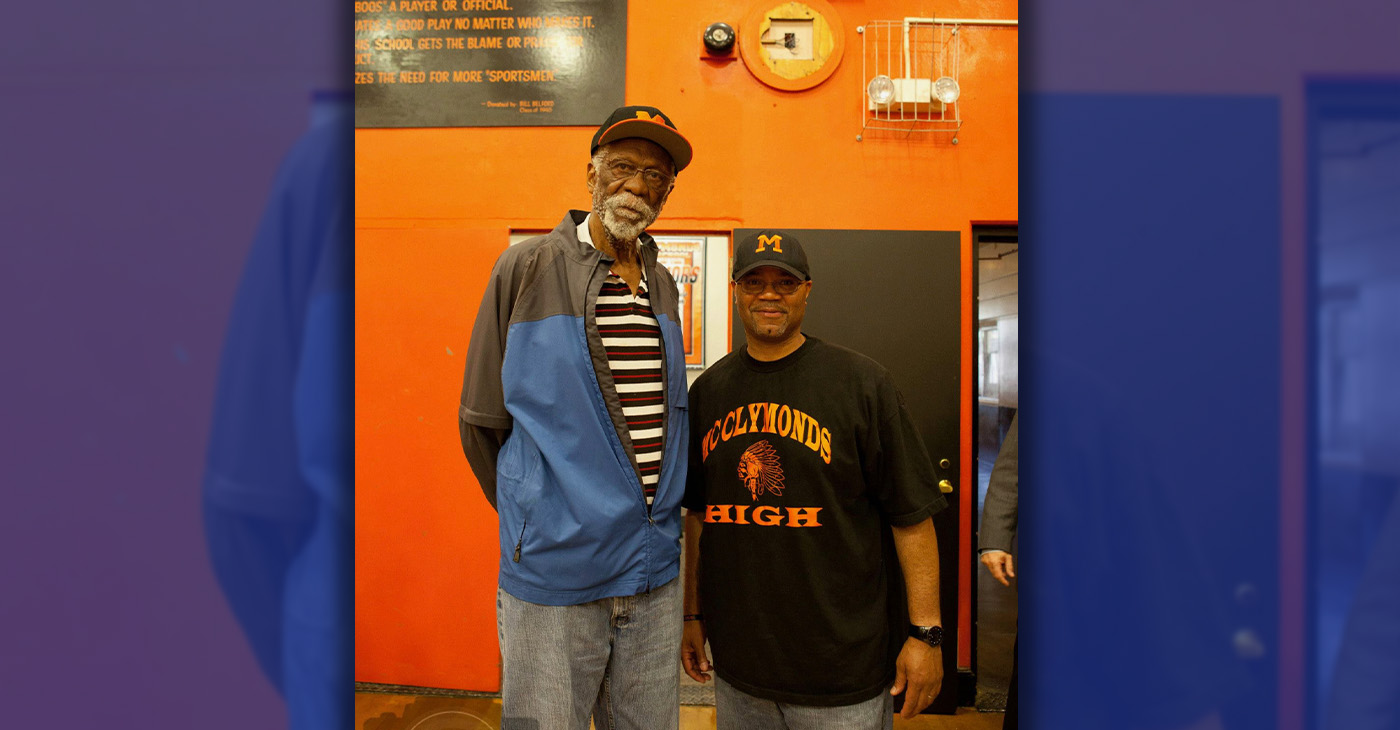
By Ken Epstein
West Oakland’s McClymonds High School, “the School of Champions,” this week named the school’s gymnasium in honor of one of its most famous graduates, basketball legend Bill Russell (class of ’52).
William “Bill” Felton Russell was born on Feb. 12, 1934, and died on July 31, 2022. He achieved fame as a U.S. professional basketball player who played center for the Boston Celtics of the National Basketball Association (NBA) from 1956 to 1969. He was the centerpiece of the Celtics dynasty that won 11 NBA championships during his 13-year career.
Russell is widely known as one of the greatest basketball players of all time. In 2011, he received the Presidential Medal of Freedom, the country’s highest civil honor, from President Barack Obama for Russell’s contributions to basketball and the Civil Rights Movement.
The McClymonds’ naming ceremony was held on Wednesday, the same day as Russell’s birthday. Oakland leader Bill Patterson, a longtime friend of Russell’s, was scheduled to cut the ribbon at the reopening of the gym, which had been closed for several months for renovation. Russell’s daughter Karen was scheduled to attend the ribbon cutting.
Russell’s name and signature are now printed on the gymnasium floor.
Patterson was working at DeFremery Park when he met Russell. “I befriended him as a boy and during his years at University of San Francisco” said Patterson. “We stayed friends for the rest of his life.”
Said McClymonds Principal Darielle Davis, herself a McClymonds graduate, “We are excited to honor Bill Russell for his sports accolades and because he broke color barriers. He is part of our legacy, and legacy is really important at McClymonds.”
Brian McGhee, community schools manager at McClymonds and former football player at UC Berkeley, said that Russell meant a lot to him and others at the school. “He was a beacon of light and hope for West Oakland,” he said. “He did a lot for sports and for civil rights.”
Starting in 2018, Ben “Coach” Tapscott worked with Patterson and other McClymonds grads, community members, and former coaches to encourage the Oakland Board of Education to endorse the naming of the school gym, which finally happened recently.
“We worked hard to make this happen,” said Tapscott. “He’s an important part of McClymond’s history, along with a lot of other famous graduates,” he said.
-

 Activism4 weeks ago
Activism4 weeks agoOakland Post: Week of November 12 – 18, 2025
-

 Activism3 weeks ago
Activism3 weeks agoIN MEMORIAM: William ‘Bill’ Patterson, 94
-

 Activism4 weeks ago
Activism4 weeks agoHow Charles R. Drew University Navigated More Than $20 Million in Fed Cuts – Still Prioritizing Students and Community Health
-

 Bay Area4 weeks ago
Bay Area4 weeks agoNo Justice in the Justice System
-

 #NNPA BlackPress3 weeks ago
#NNPA BlackPress3 weeks agoLewis Hamilton set to start LAST in Saturday Night’s Las Vegas Grand Prix
-

 #NNPA BlackPress3 weeks ago
#NNPA BlackPress3 weeks agoBeyoncé and Jay-Z make rare public appearance with Lewis Hamilton at Las Vegas Grand Prix
-

 Activism3 weeks ago
Activism3 weeks agoOakland Post: Week of November 19 – 25, 2025
-

 #NNPA BlackPress4 weeks ago
#NNPA BlackPress4 weeks agoThe Perfumed Hand of Hypocrisy: Trump Hosted Former Terror Suspect While America Condemns a Muslim Mayor

